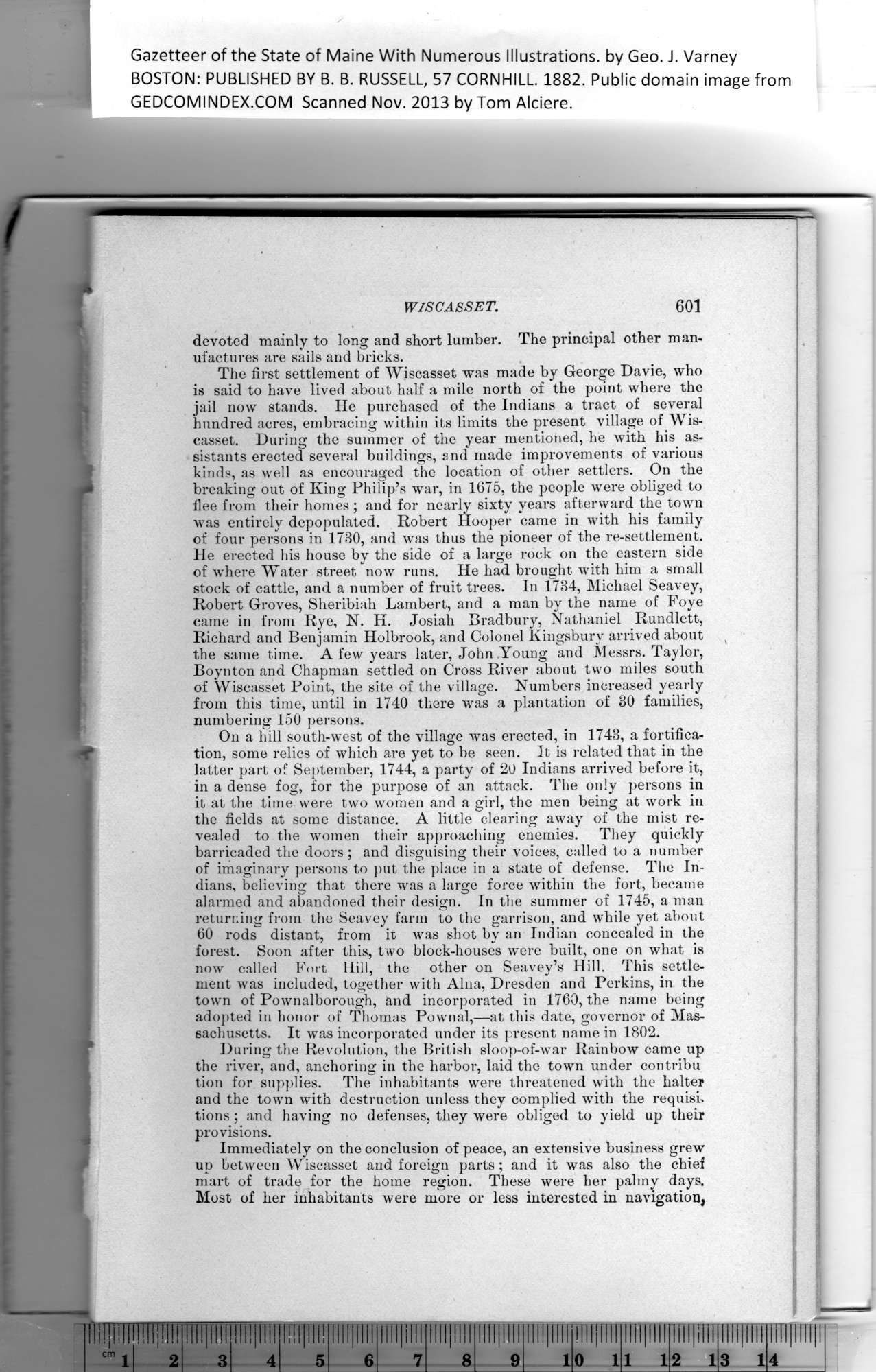|
Gazetteer of the State of Maine With Numerous Illustrations, by Geo. J. Varney
BOSTON: PUBLISHED BY B. B. RUSSELL, 57 CORNHILL. 1882. Public domain image from
WISCASSET. 601
devoted mainly to long and short lumber. The principal other man-
ufactures are sails and bricks.
The first settlement of Wiscasset was made by George Davie, who
is said to have lived about half a mile north of the point where the
jail now stands. He purchased of the Indians a tract of several
hundred acres, embracing within its limits the present village of Wis-
casset. During the summer of the year mentioned, be with his as-
sistants erected several buildings, and made improvements of various
kinds, as well as encouraged the location of other settlers. On the
breaking out of King Philip’s war, in 1675, the people were obliged to
flee from their homes ; and for nearly sixty years afterward the town
was entirely depopulated. Robert Hooper came in with his family
of four persons in 1730, and was thus the pioneer of the re-settlement.
He erected his house by the side of a large rock on the eastern side
of where Water street now runs. He had brought with him a small
stock of cattle, and a number of fruit trees. In 1734, Michael Seavey,
Robert Groves, Sheribiah Lambert, and a man by the name of Foye
came in from Rye, N. IT. Josiah Bradbury, Nathaniel Rundlett,
Richard and Benjamin Holbrook, and Colonel Kingsbury arrived about
the same time. A few years later, John Young aud Messrs. Taylor,
Boynton and Chapman settled on Cross River about two miles south
of Wiscasset Point, the site of the village. Numbers increased yearly
from this time, until in 1740 there was a plantation of 30 families,
numbering 150 persons.
On a bill south-west of the village was erected, in 1743, a fortifica-
tion, some relics of which are yet to be seen. It is related that in the
latter part of September, 1744, a party of 20 Indians arrived before it,
in a dense fog, for the purpose of an attack. The only persons in
it at the time were two women and a girl, the men being at work in
the fields at some distance. A little clearing away of the mist re-
vealed to the women their approaching enemies. They quickly
barricaded the doors; and disguising their voices, called to a number
of imaginary persons to put the place in a state of defense. The In-
dians, believing that there was a large force within the fort, became
alarmed and abandoned their design. In the summer of 1745, a man
returning from the Seavey farm to the garrison, and while yet about
60 rods distant, from it was shot by an Indian concealed in the
forest. Soon after this, two block-houses were built, one on what is
now called Fort Hill, the other on Seavey’s Hill. This settle-
ment was included, together with Aina, Dresden and Perkins, in the
town of Pownalborough, and incorporated in 1760, the name being
adopted in honor of Thomas Pownal,—at this date, governor of Mas-
sachusetts. It was incorporated under its present name in 1802.
During the Revolution, the British sloop-of-war Rainbow came up
the river, and, anchoring in the harbor, laid the town under contribu
tion for supplies. The inhabitants were threatened with the halter
and the town with destruction unless they complied with the requisi.
tions ; and having no defenses, they were obliged to yield up their
provisions.
Immediately on the conclusion of peace, an extensive business grew
up between Wiscasset and foreign parts ; and it was also the chief
mart of trade for the home region. These were her palmy days.
Most of her inhabitants were more or less interested in navigation,
PREVIOUS PAGE ... NEXT PAGE
This page was written in HTML using a program written in Python 3.2
|
